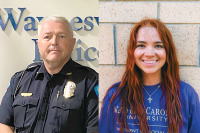New policy at Tuscola touches off student dissent
Teenage fashion continues marching onward in its evolution, leaving school administrators constantly scrambling to modernize dress codes. Keeping up with the times while maintaining a distraction-free learning environment has become a delicate dance school leaders take up year after year.
That endless tug-of-war has prompted two Haywood County high schools to take strides in opposite directions this fall.
After an experimental year with a decidedly vague dress code, Tuscola High School in Waynesville is clamping down with strict, clear-cut guidelines. All students need to comply is a card — an ID card, a driver’s license, a debit or credit card — used to measure everything from the height of skirts above the knee cap to the width of tank top straps.
Meanwhile, Central Haywood High, an alternative school in Clyde, has created a more liberal dress code, no longer requiring its students to wear belts or tuck in their shirts.
Other area schools are sticking to their stricter-than-average policies. Smoky Mountain High School in Sylva requires all skirts and dresses to be knee length or longer, while Swain County High School prohibits all tank tops or sleeveless shirts of any sort.
“Knee-length is an easy measurement,” said Jay Grissom, principal at Smoky Mountain High. “There’s no extra steps involved.”
“When spring has sprung, we get a lot of cleavage,” said Regina Mathis, who recently left her post as principal of Swain County High. “Tops are too low, shorts are too short.”
No matter how strict or liberal, though, dress codes were brought up as the number one concern of teachers in at least three WNC schools last year.
The case for stricter codes
Parents found it hard to believe their eyes as they drove up Tuscola School Drive to drop off their kids last year.
Girls donning strapless shirts and scandalously short skirts, shorts and dresses. Guys wearing tank tops and pants that were practically falling off their bodies.
“There was a lot to be seen,” said Stephanie Goodwin, assistant principal at Tuscola.
“We get to lunch, and we got half-naked bodies it seems,” said Dale McDonald, Tuscola’s principal. “It’s fine if you’re going to Myrtle Beach.”
School leaders had just debuted a radical new dress code that simply barred anything that was “disruptive.” Teachers were charged with writing up students and sending them straight to the office.
While some teachers faithfully reported dress code violations, others turned a blind eye to inappropriate outfits. That inconsistency worked against students who didn’t know what to expect with each new class. It also worked in favor of students who argued to their fourth period teacher that there hadn’t been an issue with their short shorts during homeroom.
By the end of the 2009-2010 year, Tuscola administrators acknowledged the failure of their liberal policy and got to work coming up with a replacement.
They thoroughly researched dress codes in surrounding counties and came up with what they believed constituted the middle of the road.
The basics: Students cannot wear anything shorter than a card’s length above their knees. Their tops cannot be lower than a card’s length below their collarbones. Pants must be worn at the waist with no undergarments in view and no holes above the knee. Leggings worn underneath provide no excuse for any violations of the above.
A few of the schools Goodwin looked at had dress codes that prohibited facial piercing, mascara, flip-flops and hair dye — all of which are allowed on Tuscola’s campus.
“A girl here today, her hair was rainbow,” said Goodwin. “That’s fine. That’s her way of expressing something.”
At the same time, Goodwin sees the need to set clear boundaries for attire, whether or not students agree.
“They may be used to dressing that way,” said Goodwin. “At the same time, is it the time or is it the place? School is not a time to look like you’re at the beach.”
Students fuming
Most Tuscola students were angry, or apathetic at best, over the new policy. They often echoed each other in their reactions to the new dress code.
“I think it’s stupid,” said junior Alex Dotson. “We didn’t have a dress code last year. They’re so strict on us this year.”
Dotson is particularly displeased with the longer shorts requirement.
“You can’t find any cute shorts like that unless you cut off your jeans,” Dotson said.
Like a few of her fellow students, Dotson is outright opposed to a dress code on principle.
“I think they should just let us be who we want to be and wear what we want to wear,” Dotson said.
Other students see a need for a dress code, but say the latest one is too strict.
“It’s pretty ridiculous. It think they went overboard with it,” said sophomore Brooke Ferguson. “I like the fact of having a dress code, just not one like we have. Everyone’s talking about it.”
“It doesn’t really affect me, but I know tons of girls are furious about it,” said senior Joey Cutting. “It’s hard for a lot of people. They don’t want to go out and buy a whole new wardrobe.”
“I think that a Mormon church bought our school,” joked Arron Gibson, a 17-year-old senior.
Gibson said he knew many students who had to head back to the stores to replace their wardrobes.
Eli Haynes, 15, was one of them. Many of the shorts that she bought at the beginning of the summer were suddenly prohibited at school. Her mother, Leah Crisp, wasn’t thrilled when she received notice of the new dress code six weeks before the school year started.
Though she was able to afford new clothes for Eli, Crisp pointed that not all families were as fortunate.
“What about children who may not have a lot of money?” said Crisp. “If they had told us at the end of the school year, then we would have been prepared.”
Tuscola’s latest dress code seems stricter than the one Waynesville Middle School had when Eli was attending, according to Crisp.
Though she doesn’t agree with every aspect of the code, Crisp acknowledged it would help prepare students for a professional environment once they graduate.
Principal McDonald, too, emphasized that part of the school’s job is to teach character education.
“Integrity, confidence, self-respect, all those things play into that,” said McDonald.
Gibson remains unconvinced that the stricter dress code is necessary, however.
“They claim it’s because of distraction,” Gibson said. “Any time you have a coed school, there’s going to be distraction regardless.”
The flip side
Donna Parris, lead teacher at Central Haywood High, estimates that 30 percent of the students refused to comply with the dress code last year.
It was a source of nonstop disruption in classrooms. One student after another would be removed from class, and teachers had to sacrifice breaks to monitor students’ attire during lunch.
At the heart of the problem was that students were forced to tuck in their shirts and wear belts — rules that even teachers weren’t thrilled about enforcing.
“We did not feel passionate about keeping this up and letting it interfere with our school,” Parris said. “We want to teach the kids. We don’t want to be so concerned about how they dress, as long as they’re appropriate.”
“We were spending more time on the dress code than we was on the kid getting an education,” said Tara Leatherwood, secretary for Central Haywood.
Modernizing the dress code seemed like the best option moving forward.
“We know it’s the 21st century. It’s not the 1950s,” said Jeff Haney, Central Haywood’s new principal. “We know they want to dress with style, but we also want to keep it modest.”
Many alternative schools see students only for a short stay before they return to their original schools. It isn’t uncommon for these schools to require uniforms for their temporary students. But most of the students at Central Haywood continue their education there until they graduate.
“We’re not a punishment place. We’re long-term,” said Parris. “The kids feel at home. They also wanted to feel comfortable.”
The school had required all students to wear collared shirts and khakis about six years ago. But dress requirements have been loosened ever since. Students still must wear collared shirts, but jeans, shorts and skirts in solid colors are now allowed.
With the more lenient dress code in place, Central Haywood teachers have already noticed a major improvement just a few days after school started this year.
“A couple of shorts too short, other than that, it’s been a pretty good deal,” said Parris. “The teachers are like, ‘Whew! This is so much better.’ We’re all happier.”





